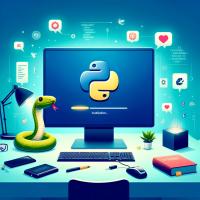How to Install Python on Windows, MacOS, Linux

Introduction
Installing Python is a fundamental step for anyone looking to dive into programming with this versatile language. This guide provides a detailed walkthrough on how to install Python on various operating systems, ensuring you can start coding with minimal setup.
Why Install Python?
Python is a powerful, high-level programming language known for its simplicity and flexibility. It is widely used in web development, data analysis, artificial intelligence, scientific computing, and more. By installing Python, you gain access to a vast ecosystem of libraries and tools that can enhance your coding projects.
Downloading Python
Before installing Python, you need to download the appropriate version for your operating system from the official Python website.
Steps to Download Python:
- Visit the official Python website: python.org
- Navigate to the "Downloads" section. The website typically suggests the best version for your OS.
- Click on the download link for your operating system (Windows, macOS, or Linux/UNIX).
Installing Python on Windows
Windows users can follow these steps to install Python.
Steps for Installation:
- Run the Installer: After downloading, open the installer. Ensure to check the box that says "Add Python 3.x to PATH" before clicking "Install Now."
- Customize Installation (Optional): You can customize the installation by clicking on "Customize Installation." Here you can choose different install locations and specific features.
- Verify Installation: Open Command Prompt and type
python --versionto verify that Python is installed correctly.
Installing Python on macOS
Mac users can install Python using the downloaded installer or through package managers like Homebrew.
Installation via Downloaded Installer:
- Open the Installer: Run the downloaded
.pkgfile and follow the on-screen instructions. - Verify Installation: Open Terminal and type
python3 --versionto check the installation.
Installation via Homebrew:
- Install Homebrew: If not already installed, open Terminal and run
/bin/bash -c "$(curl -fsSL https://raw.githubusercontent.com/Homebrew/install/HEAD/install.sh)" - Install Python: After installing Homebrew, type
brew install pythonin the Terminal. - Verify Installation: Check the version by typing
python3 --version.
Installing Python on Linux
Linux distributions often come with Python pre-installed. However, if you need to install or upgrade Python, follow these steps.
Installation on Ubuntu (Debian-based systems):
- Open Terminal: Access your terminal via shortcut or by searching for it.
- Update Package List: Run
sudo apt updateto update your package list. - Install Python: Type
sudo apt install python3to install Python. - Verify Installation: Check the installed version by typing
python3 --version.
Post-Installation Steps
Once Python is installed, consider setting up a virtual environment to manage dependencies for your projects effectively.
Setting Up a Virtual Environment:
- Install virtualenv: Run
pip install virtualenvin your command line. - Create a Virtual Environment: Navigate to your project directory and run
virtualenv myprojectenv. - Activate Virtual Environment:
- On Windows, use
myprojectenv\Scripts\activate - On macOS and Linux, use
source myprojectenv/bin/activate
- On Windows, use
Conclusion
Installing Python sets the foundation for exploring a wide range of programming tasks. Whether you're on Windows, macOS, or Linux, following these steps will help you set up Python on your computer and prepare you for an exciting coding journey.







